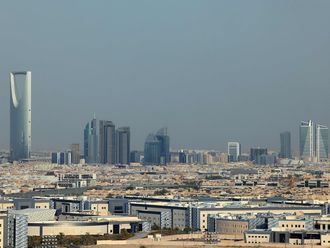Singapore
Iron ore is facing renewed pressure and risks sliding back into the $60s, as China’s economy shows signs of cooling and global mine supply increases, while planned steel capacity cuts in the world’s biggest consumer this winter could further cut demand.
Ore with 62 per cent content in Qingdao fell 2.5 per cent to $72.13 a dry metric ton on Friday, the lowest level since July 28, extending the previous day’s 3.4 per cent loss, which was the most since May, according to Metal Bulletin Ltd. The commodity, which almost hit $80 in August, posted the first back-to-back weekly decline since June.
The steelmaking raw material is in retreat after a slew of negative outlooks, with Barclays Plc saying the commodity is “living on borrowed time.” Industrial output and retail reports from China this week suggested an unexpectedly slower pace of growth. While capacity cuts to curb pollution in Asia’s top economy are set to hurt consumption, a further expansion in mine supplies from Brazil and Australia also threatens prices.
“A combination of softening demand growth from China and the outlook for increased supply create downside risk for the spot iron ore price,” said Ric Spooner, chief market analyst at CMC Markets in Sydney. “The chances are we’ll see the spot price retreat to the $60s.”
Miners’ shares dropped with ore on Friday. Rio Tinto Group and BHP Billiton Ltd. closed 2.3 per cent lower in Sydney, while Fortescue Metals Group Ltd. was down 4.5 per cent on news that Chief Executive Officer Nev Power was stepping down. The trio are Australia’s top exporters.
Much of iron ore’s recent strength has been spurred by strong demand within China, but that’s about to change, according to a Sept. 13 report from Barclays, which said its economists see an “impending end” to macroeconomic support. While the bank didn’t give a price forecast, it has said previously it sees an average of $50 by the fourth quarter.
China Cools
Data Thursday showed Chinese retail sales, industrial production and fixed assets investment slowed last month after a lacklustre July, suggesting that efforts to rein in credit expansion and reduce excess capacity are hitting home. China’s home sales grew at the slowest pace in almost three years.
As an environmental campaign intensifies, steel production, which notched a fresh monthly record in August, may drop in coming months. Hebei province, the centre of China’s mammoth steel industry, has plans to allow for output cuts of as much as 50 per cent to reduce pollution. Citigroup Inc. has estimated daily production could shrink 8 per cent because of the crackdown.
“Steel plant shutdowns will reduce demand for iron ore,” Fan Lu, an analyst at Sinosteel Futures Co., said Friday, adding there’ll also be a greater supply of ore arriving in China. “The commodity is poised to remain in a downtrend.”












